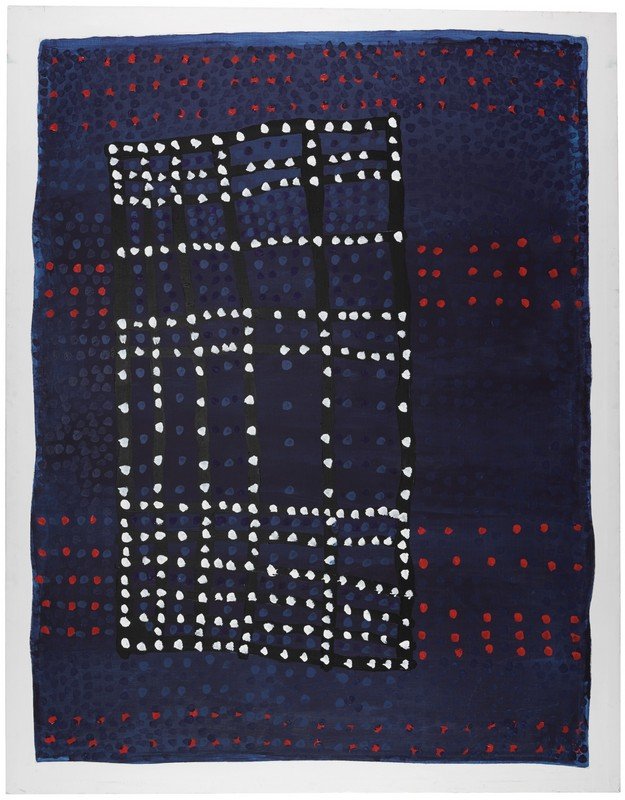PRINCE OF WALES (MIDPUL)
BIOGRAPHY

Body Marks, paint on canvas, 187 x 146 cm
Born c.1938 at Belyuen (Dellisaville), a small community on the far side of Darwin Harbour, Midpul, more familiarly known as Prince of Wales, was a custodian and leader of Larakia ceremonies and dances, a leading didgeridoo player, and practiced art as ceremonial body painting for much of his life. His father Imabul was also known as King George and this, perhaps as much as the fact that Midpul danced for Queen Elizabeth during a royal trip to Australia in the 1960s, resulted in his familiar ‘English’ name. ‘Prince’ grew up with his mother’s people, the Wadgigiyn, on the Cox Peninnsula across the harbour from Darwin, and spent much of his adult life living at the beach camp at Cullen (Kahlin) Bay, now an expensive marina development, with other Dangalaba clan members.
Despite suffering a stroke prior to gaining great recognition as an artist, he continued his lifelong practice and passion for painting and became recognized as the first contemporary Aboriginal artist from the Larakia region. His work is a unique rendering on to canvas of the traditional body designs used in Danggalaba ceremonies.
The respect afforded to Midpul by younger members of the Danggalaba tribe, was such that, despite the specific sacred cultural content of his art, no challenge was mounted when he began to produce his canvasses. As the last ‘full’ elder of the tribe, he spoke about his responsibility to reveal this sacred visual element of his culture to the mainstream. Given the hesitation from the earliest days of the contemporary Aboriginal art movement to disclose sacred symbols to the public his authority may have derived from the fact that there were simply no remaining elders alive to challenge him. Regardless, when his paintings - mostly entitled ‘Body Marks’ – came to public prominence in 2001, his work gained an immediate reputation as the up and coming art de jour of modern minimalism. It was the second year that ‘Prince’ had won the Telstra Aboriginal Art award in the General Painting Category (his previous success, in 1996, came and went with far less attention).
Prince of Wales, had works included in the National Aboriginal and Torres Strait Islander Art Award five times, held his first solo exhibition at Gallery Gabrielle Pizzi in 1997, and went on to stage another four at the Karen Brown Gallery in Darwin and the Hogarth Gallery in Sydney. Yet his death came at a time when his artistic career was only really beginning to flourish and commercial interest had begun translating into real sales. It is not difficult to see why his paintings were so quickly taken up by the art buying public, once they did come into prominence. The bold colours, broad dots and domino-like lines fit a very contemporary aesthetic.
Unfortunately this strong commercial interest only manifested at the end of his life and so much of his creative output was on a small scale, executed on cardboard scraps, paper and found objects. The artistic recognition that came with the Telstra Aboriginal Art award and a realisation of the commercial value of his work saw ‘Prince’ paint large-scale canvases only toward the end of his career. At this time his position as ‘the last ‘full-blooded’ Larakia man’ was a heritage that he strongly identified with, although his relationship to the title was ambivalent, and, at times, a heavy burden. He died on the 27th December 2002 having created a significant art legacy and laying the foundations for the emergence of a contemporary Larakia Art Movement. His work was exhibited posthumously in 2003, in the group exhibition ‘Emerge’ at the Museum and Art Gallery of Northern Territory, Darwin.
© Adrian Newstead
References
Brown, K., Prince of Wales, unpublished biographical notes, Karen Brown Gallery, Darwin. info@karenbrowngallery.com
Hetti Perkins, Tradition Today, Indigenous Art in Australia AGNSW, 2004, p166.
Toohey, Paul. Larakia Man made Unique Art out of Tribal Ceremonies, The Australian, 2003, 11.
Wells, E., (ed), Saltwater People : Larrakia Stories from Around Darwin, Larrakia Nation Aboriginal Corporation, Darwin.

